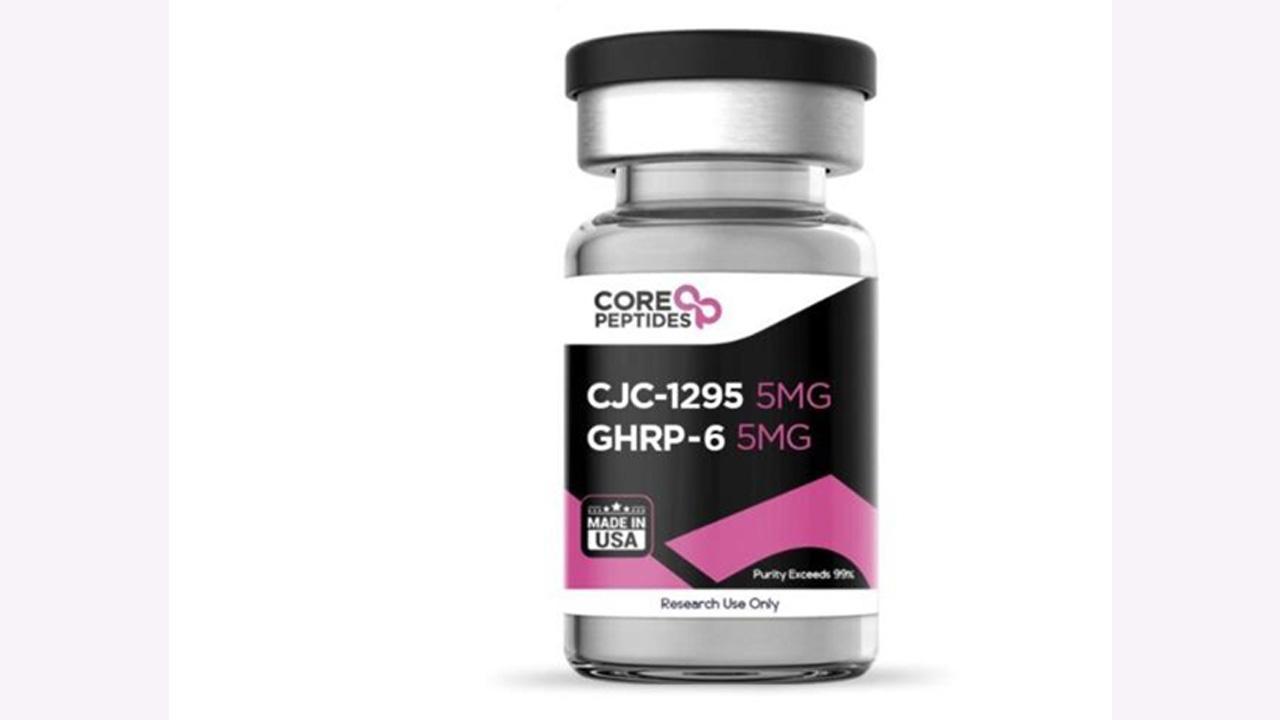The topic of this article will focus on CJC-1295 and GHRP-6 blend peptides and the multiple studies conducted on thyroid function over the years.

The potential impact of peptides CJC-1295 and GHRP-6 on the production of growth hormones have been studied. Together, they may possibly synergistically impact the body's ability to produce and release growth hormones. Studies suggest this peptide blend has the potential to aid in the healing of modest muscle and ligament injuries.
Researchers speculate that Ghrelin is a naturally occurring peptide that may promote the release of growth hormones and aid in maintaining their concentrations in the body; the GHRP-6 peptide is a synthetic six-amino-acid peptide counterpart of Ghrelin. [i]
ADVERTISEMENT
CJC-1295 peptide is an artificial analog of the naturally occurring growth hormone-releasing hormone (GHRH), which may promote the body's production of growth hormones, scientists suggest. [ii]
CJC-1295 and GHRP-6 Peptide Blend Research
CJC-1295 and Growth Hormone
Subjects that were otherwise healthy were observed in a clinical trial [iii]. Models were randomly assigned to one of two groups: those given a placebo and those given the CJC-1295 peptide. All subjects had blood drawn before and after receiving peptides to compare results. According to the data collected from these participants, researchers suggest that the peptide delivery appeared to result in a 7.5-fold rise in growth hormone levels compared to the placebo group. One week after receiving the peptide, there was no discernible change in the growth hormone levels.
Another set of study [iv] models were randomly assigned to one of two groups: those given the peptide and those given a placebo. Blood samples taken after the trial suggested an increase in growth hormone levels, up to a 10-fold increase. Madalina Ionescu et al. said, "The marked enhancement of trough GH levels by continuous GHRH stimulation may implicate the importance of this effect on potentially increasing IGF-I. Long-acting GHRH preparations may affect subjects with intact pituitary GH secretory capability."
GHRP-6 peptide [v] was given to subjects ages 6 to 11 in a research trial. The peptide was presented alone to some while in combination with the growth hormone booster arginine to others. At the end of the trial, it was suggested that all of the subjects' growth hormone levels appeared to have climbed exponentially and to the same extent, regardless of whether or not they had been given arginine.
CJC-1295 and GHRP-6 Peptide Blend and Thyroid Function
Hypothyroidism is considered to be characterized by low amounts of growth hormone in the body. Subjects with hypothyroidism were given GHRP-6 peptide, GHRH peptide, or a combination of peptides (such as CJC-1295 and GHRP-6) in a research conducted in 1997 [vi]. After the research, subjects given the blend seemed to have far higher growth hormone levels than those given the separate peptides. Studies suggest Somatostatin inhibits growth hormone release, while the GHRP-6 peptide may be an antagonist.
Somatostatin may have a part in this process, as stated by F R Pimentel-Filho et al., who suggests that "when GHRP-6 was associated with GHRH, a significant increase in the GH response was observed in these subjects." Researchers' speculations suggest that thyroid hormones may influence the release of GH in response to GHRH and GHRP-6 in distinct ways. Nevertheless, further research is needed to understand this theory better.
CJC-1295 and GHRP-6 Peptide Blend and Cell Regeneration
Injury and multi-organ failure were artificially produced in animal models used in the experiment. [vii] Then, they were given either the GHRP-6 peptide alone or the GHRP-6 plus epidermal growth factor (EGF) combination. The peptide seemed to accelerate cellular migration in the lab by a factor of three in these animal models, and this action was seen in the gut epithelial cells. In addition, it seemed to mitigate the negative outcomes associated with such a failure by a factor of 50-85%. These findings suggest that this peptide may further protect against system failure when given in conjunction with CJC-1295.
CJC-1295 and GHRP-6 Peptide Blend and Diabetes
Gastric emptying rate and colonic and intestinal transit are considered to be slowed greatly by diabetes. In studies [viii], growth hormone release-stimulating peptides (such as GHRP-6) were given to diabetically induced mice models. The findings suggest the peptide's potential to reverse diabetes-related complications seems supported by speculations that it may speed up gastric emptying and intestinal transit. Colonic transit showed no signs of changing. Zheng Q et al. suggested peptides like GHRP-6 "may have the potential for mitigating the effects of diabetes in subjects with delayed upper gastrointestinal transit."
CJC-1295 and GHRP-6 Peptide Blend and Pulse Rate
Studies in mice have suggested the potential for GHRH derivative analogs (such as the CJC-1295 peptide) in possibly stabilizing heart rate and enhancing functioning after a heart attack. Researchers Andrew V. Schally et al. suggested this peptide may increase the heart's ability to pump blood and heal damaged cardiac tissue. Based on their hypothetical findings, the team speculated that "GHRH agonists may promote repair of cardiac tissue, improving ejection fraction and reducing infarct size in rats, reducing infarct scar in swine, and attenuating cardiac hypertrophy in mice, suggesting clinical applications."
The peptide currently on the market is intended only for educational and research reasons.
More investigation is required to explore its potential in scientific research studies, and these studies must continue. Only academic and scientific institutions are allowed to use CJC-1295 and GHRP-6 peptides. If you are a licensed professional interested in buying peptides for your clinical studies, visit the Core Peptides website. Please note that none of the items mentioned are approved for human or animal consumption. Laboratory research compounds are only for in-vitro and in-lab use. Any kind of physical introduction is illegal. Only authorized professionals and working scientists may make purchases. The content of this piece is intended only for instructional purposes.
References
[i] Berlanga-Acosta, Jorge, et al. “Synthetic Growth Hormone-Releasing Peptides (GHRPs): A Historical Appraisal of the Evidences Supporting Their Cytoprotective Effects.” Clinical Medicine Insights. Cardiology vol. 11 1179546817694558. 2 Mar. 2017, doi:10.1177/1179546817694558. https://www.ncbi.nlm.nih.gov/pmc/articles/PMC5392015/
[ii] National Center for Biotechnology Information (2023). PubChem Compound Summary for CID 91976842, CJC1295 Without DAC. https://pubchem.ncbi.nlm.nih.gov/compound/CJC1295-Without-DAC.
[iii] Ionescu M, Frohman LA. Pulsatile secretion of growth hormone (GH) persists during continuous stimulation by CJC-1295, a long-acting GH-releasing hormone analog. J Clin Endocrinol Metab. 2006 Dec;91(12):4792-7. doi: 10.1210/jc.2006-1702. Epub 2006 Oct 3. PMID: 17018654. https://pubmed.ncbi.nlm.nih.gov/17018654/
[iv] Teichman SL, Neale A, Lawrence B, Gagnon C, Castaigne JP, Frohman LA. Prolonged stimulation of growth hormone (GH) and insulin-like growth factor I secretion by CJC-1295, a long-acting analog of GH-releasing hormone, in healthy adults. J Clin Endocrinol Metab. 2006 Mar;91(3):799-805. doi: 10.1210/jc.2005-1536. Epub 2005 Dec 13. PMID: 16352683. https://pubmed.ncbi.nlm.nih.gov/16352683/
[v] Bellone J, Ghizzoni L, Amaretti G, Volta C, Boghen MF, Bernasconi S, Ghigo E. Growth hormone-releasing effect of oral growth hormone-releasing peptide 6 (GHRP-6) administration in children with short stature. Eur J Endocrinol. 1995 Oct;133(4):425-9. https://pubmed.ncbi.nlm.nih.gov/7581965/
[vi] Pimentel-Filho FR, Ramos-Dias JC, Ninno FB, Façanha CF, Liberman B, Lengyel AM. Growth hormone responses to GH-releasing peptide (GHRP-6) in hypothyroidism. Clin Endocrinol (Oxf). 1997 Mar;46(3):295-300. https://pubmed.ncbi.nlm.nih.gov/9156038/
[vii] Cibrián D, Ajamieh H, Berlanga J, León OS, Alba JS, Kim MJ, Marchbank T, Boyle JJ, Freyre F, Garcia Del Barco D, Lopez-Saura P, Guillen G, Ghosh S, Goodlad RA, Playford RJ. Use of growth-hormone-releasing peptide-6 (GHRP-6) for the prevention of multiple organ failure. Clin Sci (Lond). 2006 May;110(5):563-73. https://pubmed.ncbi.nlm.nih.gov/16417467/
[viii] Zheng, Q., Qiu, W. C., Yan, J., Wang, W. G., Yu, S., Wang, Z. G., & Ai, K. X. (2008). Prokinetic effects of a ghrelin receptor agonist GHRP-6 in diabetic mice. World journal of gastroenterology, 14(30), 4795–4799. https://www.ncbi.nlm.nih.gov/pmc/articles/PMC2739343/
Disclaimer: The views and opinions expressed in this sponsored article are those of the sponsor/author/agency and do not represent the stand and views of Mid-Day Group.Mid-Day Group disclaims any and all liability to any party, company or product for any direct, indirect, implied, punitive, special, incidental or consequential damages arising directly or indirectly from the use of this content.
 Subscribe today by clicking the link and stay updated with the latest news!" Click here!
Subscribe today by clicking the link and stay updated with the latest news!" Click here!








